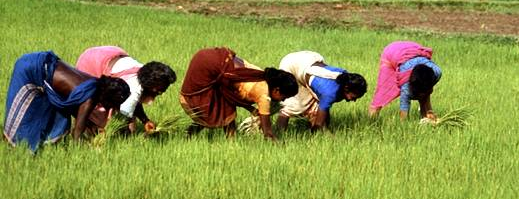
Usually history books depict the development of ancient Indian Civilization as starting from Mehrgarh (from 7000 – 3300 BCE) and then moving to the Indus Valley. The Indus Valley civilization flourished from 3300 BCE to 1700 BCE and then the settlements moved to the Ganges plains, probably due to reduced monsoons or due to the disappearance of the Ghaggar-Hakra river system. It was assumed that the Ganges plains had dense forests and people did not have the tools to clear the forests till about 3500 years back.
Our understanding of the development in the Ganges plains are changing due to the work done by the scientists from the Birbal Sahni Institute of Palaeobotany and Lucknow University.
..analysed pollen and chemical signatures in mud dug up from a two-metre-deep hole in the dry lake bed of Sanai Tal, between Rae Bareli and Lalganj in eastern Uttar Pradesh. Ancient pollen yields information about vegetation, while changes in the monsoon are reflected in the signatures of chemical elements buried in lake sediments.
“Our findings suggest that people lived in the Sanai lake region 15,000 years ago,” said Mohan Singh Chauhan, a scientist at Birbal Sahni Institute. But the Sanai lake bed tells a different story: of a seesawing monsoon affecting vegetation and human activity.
The pollen analysis shows that the Ganga plain was a savannah grassland with a few pockets of forests. The scientists also found “cultural pollen” — pollen from plants that grow at sites of human habitation. “Cultural pollen is indirect evidence for human presence and we found it throughout the 15,000-year history of Sanai Tal,” Chauhan said.
The lake itself formed about 12,500 years ago, during a period when the monsoon gained in strength. But the region experienced a 1,000-year spell of dry weather between 11,500 years and 10,500 years ago. During the period, there was a clear decline in the growth of trees around the Sanai Tal, the scientists said.
The levels of cultural pollen — in other words, human activity in the region — also dramatically declined during this dry spell.
The studies show the largest expansion of the lake occurred between 10,000 years and 5,800 years ago, a period corresponding to heavier monsoons. Early during this period, Chauhan said, the region witnessed the beginnings of agriculture.
Excavations at some 9,000-year-old sites in Pratapgarh district, about 100 km east of Sanai Tal, had earlier shown evidence of farming. From 5,000 years ago to the present, the levels of cultural pollen — including pollen from cultivated plants — increases significantly. During this period, the Ganga plain is believed to have witnessed a largescale influx of people.
Previous discoveries in Lahura-Deva site near Sanai Tal have given indication that the Middle Ganga Valley could be home to one of the oldest farming sites in the world, where agriculture developed independently (with respect to West Asia and China).